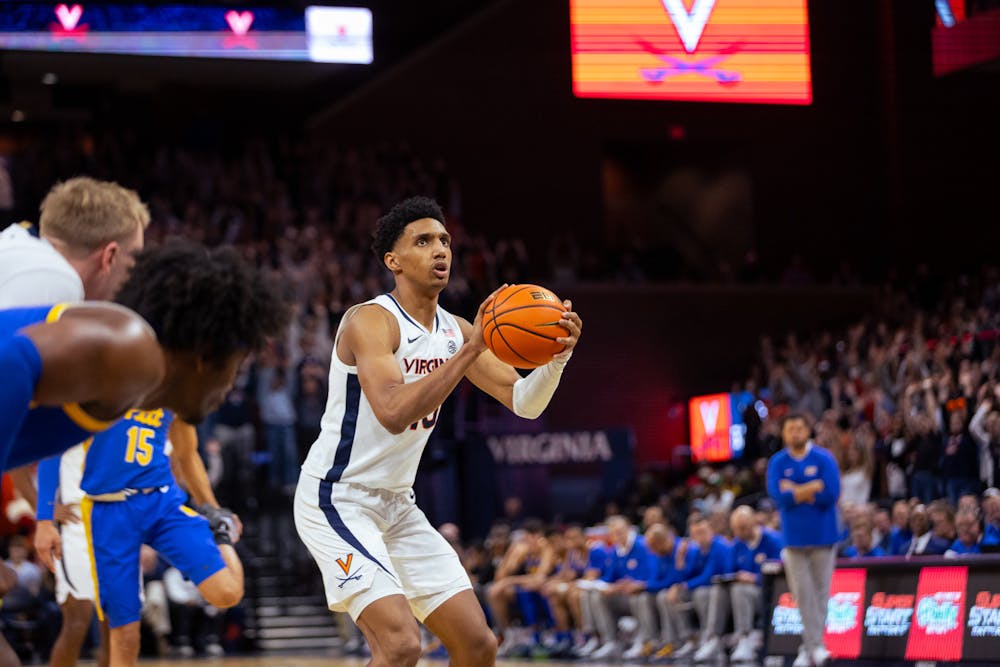Virginia men’s basketball cannot shoot free throws. This season, the Cavaliers are making 64.3 percent of their shots at the free throw line — that statistic ranks 342nd out of 351 Division I basketball teams and last in the ACC by over four percent. Pair this with Virginia’s notably slow pace of play and Coach Tony Bennett’s team makes only 9 free throws per game, a number lower than all but two teams nationwide — Hofstra and Army West Point.
Virginia’s struggles at the line have been prevalent throughout the year, but they culminated Feb. 17 against Wake Forest when the Cavaliers missed 10 consecutive shots from the charity stripe. That’s right — Virginia was 0-10 on free throws at one time, saved only by sophomore guard Isaac McKneely’s conversion from the line with six seconds remaining.
The craziest part is McKneely’s shot put the Cavaliers up by two points, and they ended up beating the Demon Deacons. Virginia’s outstanding defensive display — highlighted by 13 blocked shots, 12 forced turnovers and Wake Forest’s 34.5 percent shooting from the field — propelled them to an ugly 49-47 win.
While some may view the Wake Forest game as promising — the Cavaliers managed to win a conference matchup while shooting below 10 percent from the free throw line — the game should ring alarm bells for Virginia fans everywhere. The Cavaliers may not shoot any worse than they did against Wake Forest this campaign, but they probably won’t shoot much better either — this is nothing new.
Virginia has failed to make 70 percent of its free throw attempts in 19 out of 28 games this season. That percentage should be the minimum mark for the Cavaliers, and it has been for over a decade — Virginia has not shot below 70 percent on free throws in a single season since 2014. The 2024 edition of Bennett’s team reaches that threshold less than once every three games.
While freshman forward Blake Buchanan and graduate forward Jordan Minor have shown their struggles — the duo shoots 52.4 percent and 57.5 percent on free throws, respectively — most college basketball teams have a few frontcourt players like Buchanan and Minor who have yet to develop a consistent set shot. They therefore don’t hold the Cavaliers back in any special way.
The most worrying problem for the Cavaliers, in this department, is their guards. Of Virginia’s six backcourt players who receive consistent minutes, four shoot below Virginia’s team free throw percentage. That list includes sophomore guards Ryan Dunn and Andrew Rohde — who shoot at 53.6 percent and 42.9 percent, respectively — junior guard Dante Harris at 50 percent and junior guard Taine Murray at 61.1 percent. Combined, the quartet has made only 62 of their 117 free throw attempts — just 52.9 percent — for the season. McKneely and senior guard Reece Beekman help pull that average up slightly with 88.6 and 75 percent rates from the foul line, but Virginia’s collective guard group is objectively substandard in terms of their free throw shooting ability.
It is true that the Cavaliers’ free throw liabilities haven't directly resulted in a loss for the team yet, as all eight of Virginia’s losses have been by double digits and can be attributed more to other problems. However, Bennett and company have walked a thin line in several wins because of their struggles at the line.
The Cavaliers made only five out of 10 free throws in the final four minutes of their 73-70 win over Florida Nov. 10, allowing the game to come down to the final possession when it could have been salted away minutes prior. Less than two weeks later, Virginia escaped with a two-point victory over West Virginia, in which Beekman and Dunn each misfired on free throws in the final two seconds, allowing the Mountaineers to stay within one score of the win.
In a Dec. 16 contest against Northeastern, the Cavaliers were nearly dealt a season-crushing defeat at home after shooting 10-18 from the free throw line. Rohde had a chance to ice the game with under a second remaining and Virginia leading by two points, but he missed the first shot of a one-and-one and gave the Paws a chance to win. Virginia slipped by 56-54, but questions loomed about the team’s ability to close out games.
The Cavaliers have also played with fire in the ACC in recent weeks, shooting 5-9 on free throws in their overtime period against NC State Jan. 24, which resulted in a narrow 59-53 win. In the aforementioned Wake Forest matchup last week, Virginia made one of its nine free throw attempts in the final seven minutes in a game that should have been won by double digits.
In total, that is four instances in which the Cavaliers’ poor free throw shooting has forced them to play with the game in the balance down to the final possession. Virginia did enough defensively to eke out wins in each of those contests, but when postseason play comes around and the games are win-or-go-home, it will take only one subpar free throw shooting performance to send the Cavaliers packing.
Virginia fans remember all too well what happened last March in the team’s 68-67 upset defeat by Furman in the first round of the NCAA Tournament. The Cavaliers missed two key free throws in the final 35 seconds of action — a McKneely miss on the front end of a one-and-one and a one-for-two trip from Kihei Clark — which kept the Paladins within reach before they eventually broke Virginia fans’ hearts. That game is a perfect example of what the Cavaliers will be susceptible to in postseason play in the coming weeks. Virginia’s free throw problem is much more extreme than in 2023, and it will cost the team their season if it continues.







